![]() 1st Battalion 22nd Infantry
1st Battalion 22nd Infantry ![]()
The 22nd Infantry in Germany 1951-1953
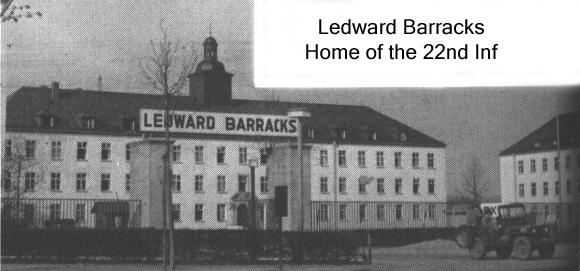
Ledward Barracks, Schweinfurt, Germany 1951-52
The American soldiers who spearheaded the
Allied crusade that defeated the Axis armies in Europe and
liberated Western Europe
took up postwar occupation duties in Germany, Austria, Italy, and
in the free territory of Trieste. As military governors,
the U.S. Army helped former enemies restore civic order and
democratic institutions.
The Army helped war-torn Western European nations rebuild their
tattered economies and eased the plight of thousands of refugees
and displaced persons.
As tensions increased between the Western democracies and the
Soviet Union -- which had created communist regimes among its
satellite nations
in Eastern Europe and in the Soviet Zone of occupied Germany --
an "Iron Curtain" fell across Europe. The Iron Curtain
divided East from West,
totalitarian communism from freedom and democracy.
As the Cold War intensified in Europe, the Army's role changed
from an occupying and constabulary force to a sentinel of
freedom.
Most U.S. Army forces in Europe were in Germany, assigned to the
U.S. Army, Europe. USAREUR evolved into the Army component
command
of the joint U.S. European Command. The U.S. commitment to the
security of Western Europe, which American leaders believed vital
to American national security, was underscored when in 1950 the
U.S. joined the North Atlantic Treaty Organization, created a
year earlier for the collective defense of free Europe against
possible Soviet aggression.
For more than 40 years, the forces of USAREUR and Seventh Army
served as a deterrent and defense to Soviet expansion -- a shield
of democracy.
From a strength of about 79,000 in 1950, USAREUR grew to a
strength of more than 250,000 ten years later. Its two corps,
four divisions,
and two armored cavalry regiments, the bulwark of NATO's Central
Army Group, maintained a vigil on the borders of East Germany and
Czechoslovakia.
above is edited from the article
USAREUR as NATO's Shield of Democracy by
Vincent Demma
taken from the Army
News Service
**********************
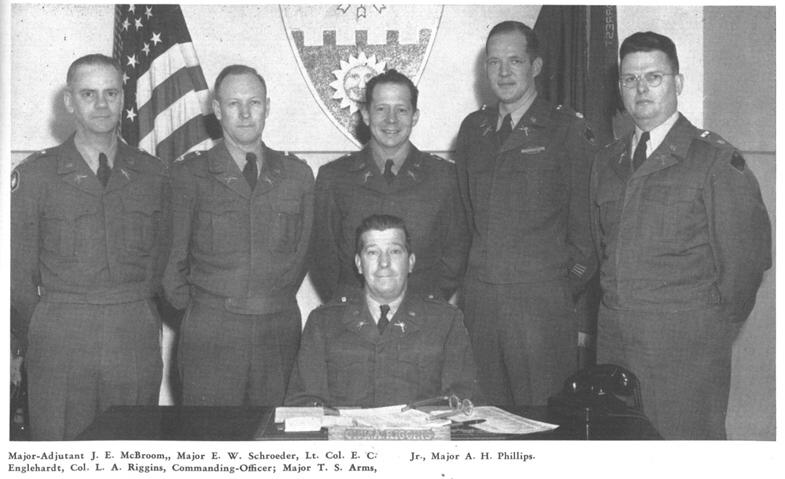
22nd Infantry Regimental Staff - Germany 1951-53
From 1948 to 1950, the Cold War began to warm,
and the outbreak of hostilities in Korea heightened East-West
tensions in Europe.
The Seventh Army was reactivated at Stuttgart in late November
1950, the V and VII Corps headquarters were organized,
and four divisions were alerted to move back to Europe from the
United States. The first to arrive was the 4th Infantry Division
in May 1951,
followed by the 2nd Armored Division and the 43rd and 28th
Infantry Divisions during summer and fall of 1951.
Arriving in Germany in 1951 as part of the 4th
Infantry Division, the 22nd Infantry thus began
a five year deployment to that country, first being headquartered
at Schweinfurt,
then at Giessen, and finally at Kirchgoens.
|
In 1951 the 4th Infantry
Division area of responsibility |
Training Program During
Past 12 Months Keeps Ivy Units Busy at Home, in Field
By Sgt Ken
Walker
(Source:
"4th Infantry Division, 1917-1953." Special Section of IVY
LEAVES, the 4th Infantry Div newspaper, October 8, 1953)
In and out of the field, to and
from the classroom, out to the range and back, in the air and on
the ground,
training took a major slice out of the daily routine of 4th
Division men during the past year.
In individual weapons firing, in squad and platoon tactics, in
company and battery and battalion alerts and CPXs,
in regimental and division maneuvers and problems, the Ivyman of
the past 12 months was trained and retrained and trained again,
until even the individual began to believe he was combat ready.
His leaders knew it.
Basic style training In drill and PT and manual of arms was not
forgotten. Over and above such fundamentals rose a structure of
preparedness
built on teamwork -- teamwork between individuals and between the
larger units.
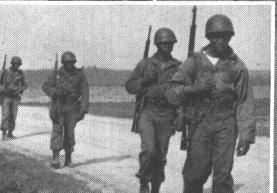
22nd Infantry soldiers on road march
The best example of such teamwork about a year
ago was "Exercise Rosebush," the mammoth French and
American maneuvers
which gave a workout to some 75,000 troops including the 4th Inf
Div and ended in September with praise for all concerned.
"Rosebush" kept the 4th Inf Div in the field for 72
hours, in a simulated defense of a powerful "Aggressor"
push from the East toward the Rhine River.
Ivymen, among the defenders, were instrumental in halting the
armored thrusts toward Giessen at the conclusion of the exercise,
slowing the "Aggressor" to a far greater extent than
was their mission.
Especially praised was the average Ivyman's awareness of the
importance of security and teamwork. Camouflage also got a pat on
the back.
During "Rosebush" one small Ivy unit pulled an unusual
escape, after having been surrounded by "Aggressors"
during the night.
The unit dispatched a messenger to the enemy CP with a request
for clearance for the unit to move forward. No enemy personnel
checked identification,
and the request was granted. The "Aggressor" even
furnished an MP escort to speed the friendly troops on their way.
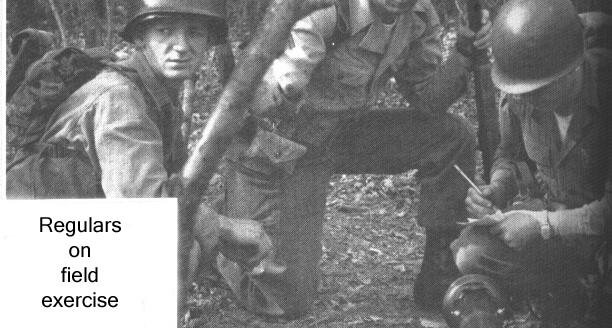
The 22nd and
8th Inf Regts saw most of the action during "Rosebush,"
while the 12th was held in reserve and had to be content with
light skirmishes.
Together with the 14th Armd Cav Regt and other allied units, the
4th Inf Div at the close of the problem had thrown up a defensive
wall
before the city of Giessen that the "Aggressor" could
not crack.
In the middle of September, the majority of Ivymen were still
remembering "Rosebush." A few had other things more
important to think about
concerning their personal training. Two non-coms, one from the
8th and one from the 22d Inf Regt, departed for
the States, temporarily,
to attend the Army Helicopter Transport Pilot School at Ft. Sill,
Okla. They were promoted to warrant officer junior grade at the
end of the 17 week course
In the 8th Inf Regt, the number of men
attending Army training schools simultaneously in mid-November
was 146.
USAREUR and Seventh Army schools were teaching Ivymen everything
from cooking to defensive chemical warfare.
The 22d Regt, in additlon, scheduled five
schools of its own: voice radio, driving, typing, military
tactics and basic education.
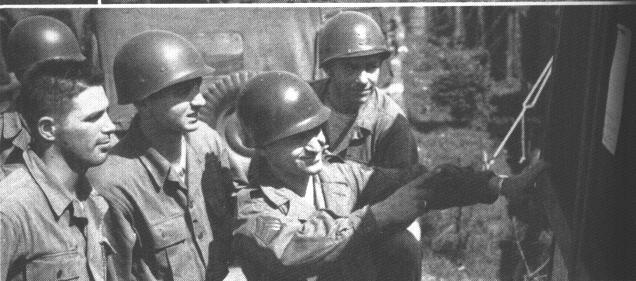
NCO giving instruction
A series of training classes to indoctrinate
Ivymen in methods of keeping warm and preventing frostbite,
chills and frozen feet
while participating in winter outdoor training was begun in
December under the direction of the G3 section. The four-phase
instruction included:
cold injury, clothing and equipment, heat, shelter, water and
food, and first aid and hygiene.
At the turn of the year, each Infantry battalion and Engineer
company in the division underwent a week's training in surviving
winter conditions.
The troops were taught how to move, shoot and best exist during
severe winter conditions. Included was training in skiing and
snow-shoeing.
A mammoth five-day river crossing,
"Exercise Boatride," began February 2, and reached its
climax on the fourth day
as all three regiments assaulted the Main River in a pre-daybreak
attack.
It was the largest assault river crossing for the division since
its reactivation in October 1950.
The problem not only developed technical procedures involved in
getting from one side of the river to the other without bridges
but provided the practical training necessary for repeat
performances, if needed.
After moving into a staging area the first day, the 4th Division
units spent the next day getting the "Friendly" bank
cleared of scattered "Aggressor" units.
The third morning all units sent out patrols to co-ordinate the
crossing.
On the morning of the fourth day, assault troops stormed across
the river before dawn routing the Armored "Aggressor"
forces from the beachhead
on the far side. The assault climaxed two full days of
round-the-clock probing of the enemy lines in snow and bitter
cold.
The first waves went over in plywood boats and on rubber rafts,
while succeeding waves used landing craft, DUKWs or rubber rafts
propelled by motor launches. Engineers immediately began working
to complete two pontoon bridges, screened from observation by
smoke generators.
The first Ivy armor moved across the river just before noon on M2
rafts constructed from Treadway bridge sections. Supporting
elements crossed
the same evening and the final morning, while the Infantry
expanded the bridgehead. Counter-attacks on the fifth morning
were repulsed.
In mid-February, such things as rifle squad in
the attack, platoon in the attack and both in defense, began to
take the individual Ivyman's attention.
At the same time, the 22d Inf Regt received its
new 4.2 mm mortars and began training their heavy mortar company
in earnest
and a new heavy weapons school was opened for men of the same
unit. The school offered a ten-week course in indirect fire,
particularly in the use of the 75 and 57 mm recoilless rifles and
the .30 cal machine gun.
Above: 2 1/2 ton trucks of 22nd
Infantry Right: Regulars take a break |
|
March..................At the same time, the 1st
Bn of the 22d Inf Regt began field training anew, this
time stressing the use of tanks in the attack,
coupled with company-level problems and platoon in attack and
defense situations, culminating in an assault with live
ammunition.
The 22d Regt's 2d BN climaxed
a 14-day field training exercise as March ended with a night
attack problem lasting 12 hours.
The training included firing of individual weapons at known
distances. Individual weapons firing was augmented by
qualification tests
for 3.5-inch rocket launcher and the .30 cal and .50 cal machine
guns. A physical training test finished the two-week activities.
|
Late in April, the biggest chapter
in the 1952-1953 training story began to unfold as the
entire division converged in sections and separate units
on one of the U.S. Army's largest field training areas in
Germany. From that time until mid-June, garrison life was
reluctantly forgotten under the rigors of life in
realistic field training. As May hurried on, Double-Time-On-Target tests were conducted by the 22d and the results added much to the effectiveness of the unit. |
| All Infantry units in the division also went through
hand grenade training, bayonet drill, rifle grenade
exercises, bazooka firing, camouflage training and
endless foxhole and gun emplacement digging. Tactical air command programs also hit all units of the division, with low-flying Piper Cubs simulating aircraft attacks and support for ground units. As the training drew to a close, the picture came into focus for the troops. Larger units participated in larger-scale war games, such as battalions holed up in the ruins of an abandoned German town, awaiting an attack by "Aggressors" in force. Many lessons were learned as the men began to see where they fitted into their units in actual combat-style action. A display of explosive demolition was given by the 4th Engr Bn, which unexpectedly touched off a small forest fire in the area. The demonstrators showed their own safety precautions as they quickly brought the blaze under control with a bucket brigade using helmets full of sand. June's first two weeks brought the training to a close
with major large scale problems, mostly on battalion
level. Live ammo was the usual thing as the battalions
smashed through full-strength problems in both attack and
defense. When the division returned to garrison later in June, training went on, but not at the 24-hour-a-day pace of the field. |
|
**********************
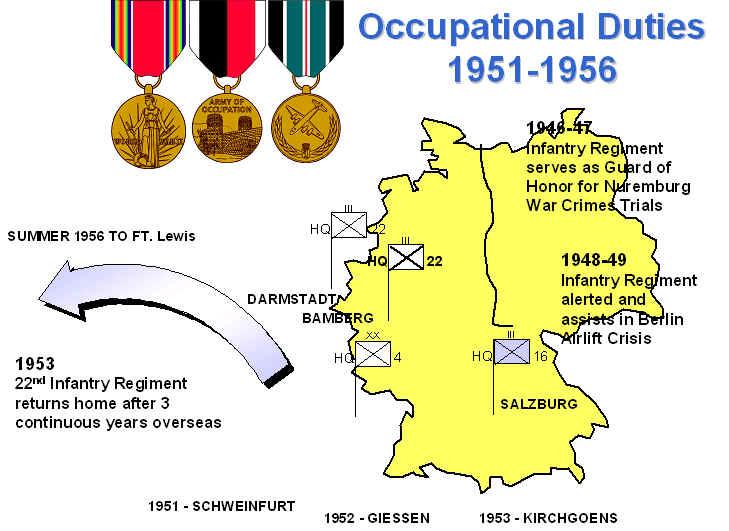
Disposition of 22nd Infantry in Germany 1946-1956
Graphic from the 1-22 IN website
under direction of LTC Steve Russell during the Battalion's duty
at Fort Hood Texas, 2003-2004
**********************
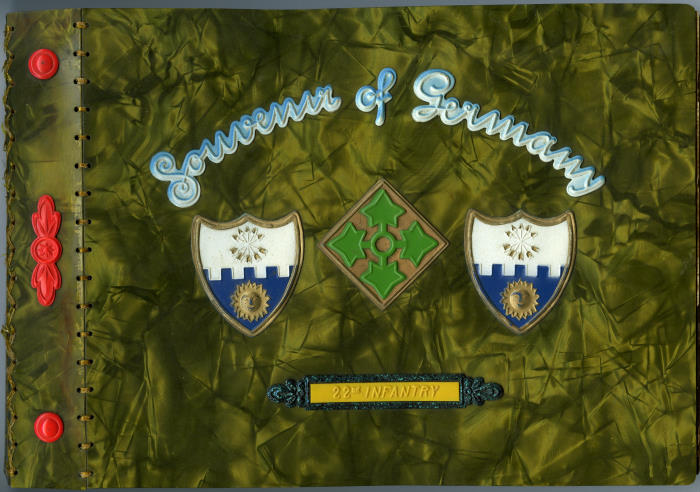
Photo album for the 22nd Infantry Regiment in Germany during the 1950's
From the webmaster's collection
**********************
The above text was edited, with permission from the webmaster, from the website
U.S. Army in Germany
from Occupation Army to "Keepers of the Peace"
1945 - 1989
Photos taken from the 22nd Infantry Regiment
section of the 4th Infantry Division European Command 1951-52
yearbook
Occupation of Germany 1952
published by ALBERT LOVE ENTERPRISES Atlanta, Georgia
Home | Photos | Battles & History | Current |
Rosters & Reports | Medal of Honor | Killed
in Action |
Personnel Locator | Commanders | Station
List | Campaigns |
Honors | Insignia & Memorabilia | 4-42
Artillery | Taps |
What's New | Editorial | Links |